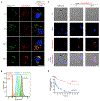Cell-specific cargo delivery using synthetic bacterial spores
- PMID: 36640333
- PMCID: PMC10009695
- DOI: 10.1016/j.celrep.2022.111955
Cell-specific cargo delivery using synthetic bacterial spores
Abstract
Delivery of cancer therapeutics to non-specific sites decreases treatment efficacy while increasing toxicity. In ovarian cancer, overexpression of the cell surface marker HER2, which several therapeutics target, relates to poor prognosis. We recently reported the assembly of biocompatible bacterial spore-like particles, termed "SSHELs." Here, we modify SSHELs with an affibody directed against HER2 and load them with the chemotherapeutic agent doxorubicin. Drug-loaded SSHELs reduce tumor growth and increase survival with lower toxicity in a mouse tumor xenograft model compared with free drug and with liposomal doxorubicin by preferentially accumulating in the tumor mass. Target cells actively internalize and then traffic bound SSHELs to acidic compartments, whereupon the cargo is released to the cytosol in a pH-dependent manner. We propose that SSHELs represent a versatile strategy for targeted drug delivery, especially in cancer settings.
Keywords: Bacillus subtilis; CP: Cancer; Doxil; SpoIVA; SpoVM; drug delivery; microparticle; nanoparticle; spore; sporulation; synthetic biology.
Published by Elsevier Inc.
Conflict of interest statement
Declaration of interests K.S.R. and I.W. are inventors on a patent describing SSHEL technology that has been assigned to the US government.
Figures




References
-
- Seymour LW (1992). Passive tumor targeting of soluble macromolecules and drug conjugates. Crit. Rev. Ther. Drug Carrier Syst 9, 135–187. - PubMed
Publication types
MeSH terms
Substances
Grants and funding
LinkOut - more resources
Full Text Sources
Medical
Research Materials
Miscellaneous

